-
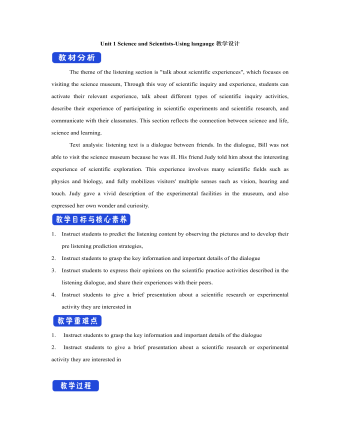
新人教版高中英语选修2Unit 1 Science and Scientists-Using langauge教学设计
This happens because the dish soap molecules have a strong negative charge, and the milk molecules have a strong positive charge. Like magnets, these molecules are attracted to each other, and so they appear to move around on the plate, taking the food coloring with them, making it look like the colors are quickly moving to escape from the soap.Listening text:? Judy: Oh, I'm so sorry that you were ill and couldn't come with us on our field trip. How are you feeling now? Better?? Bill: Much better, thanks. But how was it?? Judy: Wonderful! I especially liked an area of the museum called Light Games.it was really cool. They had a hall of mirrors where I could see myself reflected thousands of times!? Bill: A hall of mirrors can be a lot of fun. What else did they have?? Judy: Well, they had an experiment where we looked at a blue screen for a while, and then suddenly we could see tiny bright lights moving around on it. You'll never guess what those bright lights were!? Bill: Come on, tell me!? Judy: They were our own blood cells. For some reason, our eyes play tricks on us when we look at a blue screen, and we can see our own blood cells moving around like little lights! But there was another thing I liked better. I stood in front of a white light, and it cast different shadows of me in every color of the rainbow!? Bill: Oh, I wish I had been there. Tell me more!? Judy: Well, they had another area for sound. They had a giant piano keyboard that you could use your feet to play. But then, instead of playing the sounds of a piano, it played the voices of classical singers! Then they had a giant dish, and when you spoke into it, it reflected the sound back and made it louder. You could use it to speak in a whisper to someone 17 meters away.? Bill: It all sounds so cool. I wish I could have gone with you? Judy: I know, but we can go together this weekend. I'd love to go there again!? Bill: That sounds like a great idea!
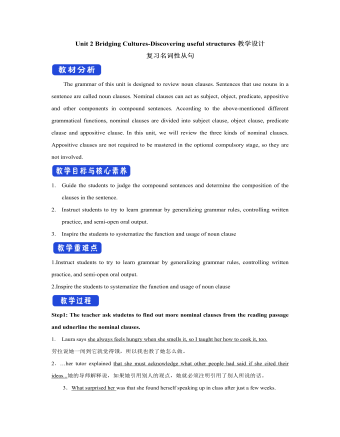
新人教版高中英语选修2Unit 2 Bridging Cultures-Discovering useful structures教学设计
The grammar of this unit is designed to review noun clauses. Sentences that use nouns in a sentence are called noun clauses. Nominal clauses can act as subject, object, predicate, appositive and other components in compound sentences. According to the above-mentioned different grammatical functions, nominal clauses are divided into subject clause, object clause, predicate clause and appositive clause. In this unit, we will review the three kinds of nominal clauses. Appositive clauses are not required to be mastered in the optional compulsory stage, so they are not involved.1. Guide the students to judge the compound sentences and determine the composition of the clauses in the sentence.2. Instruct students to try to learn grammar by generalizing grammar rules, controlling written practice, and semi-open oral output.3. Inspire the students to systematize the function and usage of noun clause1.Instruct students to try to learn grammar by generalizing grammar rules, controlling written practice, and semi-open oral output.2.Inspire the students to systematize the function and usage of noun clauseStep1: The teacher ask studetns to find out more nominal clauses from the reading passage and udnerline the nominal clauses.
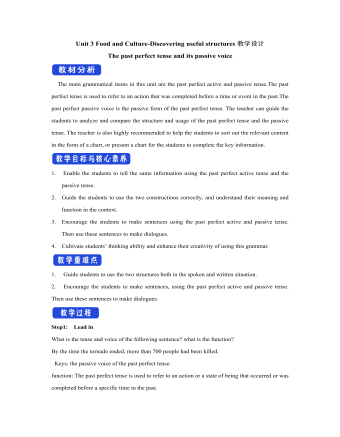
新人教版高中英语选修2Unit 3 Food and Culture-Discovering useful structures教学设计
The newspaper reported more than 100 people had been killed in the thunderstorm.报纸报道说有一百多人在暴风雨中丧生。(2)before、when、by the time、until、after、once等引导的时间状语从句的谓语是一般过去时,以及by、before后面接过去的时间时,主句动作发生在从句的动作或过去的时间之前且表示被动时,要用过去完成时的被动语态。By the time my brother was 10, he had been sent to Italy.我弟弟10岁前就已经被送到意大利了。Tons of rice had been produced by the end of last month. 到上月底已生产了好几吨大米。(3) It was the first/second/last ... time that ...句中that引导的定语从句中,主语与谓语构成被动关系时,要用过去完成时的被动语态。It was the first time that I had seen the night fact to face in one and a half years. 这是我一年半以来第一次亲眼目睹夜晚的景色。(4)在虚拟语气中,条件句表示与过去事实相反,且主语与谓语构成被动关系时,要用过去完成时的被动语态。If I had been instructed by him earlier, I would have finished the task.如果我早一点得到他的指示,我早就完成这项任务了。If I had hurried, I wouldn't have missed the train.如果我快点的话,我就不会误了火车。If you had been at the party, you would have met him. 如果你去了晚会,你就会见到他的。
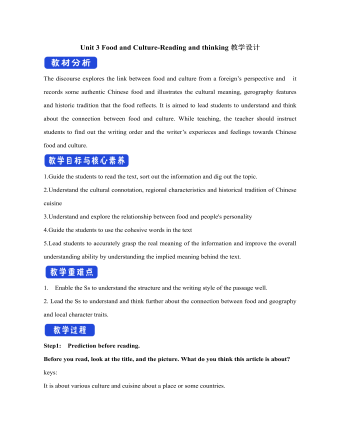
新人教版高中英语选修2Unit 3 Food and Culture-Reading and thinking教学设计
The discourse explores the link between food and culture from a foreign’s perspective and it records some authentic Chinese food and illustrates the cultural meaning, gerography features and historic tradition that the food reflects. It is aimed to lead students to understand and think about the connection between food and culture. While teaching, the teacher should instruct students to find out the writing order and the writer’s experieces and feelings towards Chinese food and culture.1.Guide the students to read the text, sort out the information and dig out the topic.2.Understand the cultural connotation, regional characteristics and historical tradition of Chinese cuisine3.Understand and explore the relationship between food and people's personality4.Guide the students to use the cohesive words in the text5.Lead students to accurately grasp the real meaning of the information and improve the overall understanding ability by understanding the implied meaning behind the text.1. Enable the Ss to understand the structure and the writing style of the passage well.2. Lead the Ss to understand and think further about the connection between food and geography and local character traits.Step1: Prediction before reading. Before you read, look at the title, and the picture. What do you think this article is about?keys:It is about various culture and cuisine about a place or some countries.
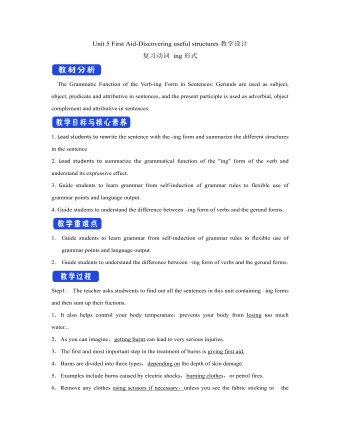
新人教版高中英语选修2Unit 5 First Aid-Discovering useful structures教学设计
You have no excuse for not going.你没有理由不去。He was punished for not having finished his homework.他因未完成作业而受到惩罚。2.动词ing形式复合结构由物主代词或人称代词宾格、名词所有格或普通格加动词ing,即“sb./sb.'s+doing”构成。动词ing形式的复合结构实际上是给动词ing形式加了一个逻辑主语。动词ing形式的复合结构有四种形式:①形容词性物主代词+动词ing②名词所有格+动词ing③代词宾格+动词ing④名词+动词ingHer coming to help encouraged all of us.她来帮忙鼓舞了我们所有人。The baby was made awake by the door suddenly shutting.这个婴儿被突然的关门声吵醒了。Can you imagine him/Jack cooking at home?你能想象他/杰克在家做饭的样子吗?无生命名词无论是作主语还是作宾语都不能用第②种形式。Tom's winning first prize last year impressed me a lot.汤姆去年得了一等奖使我印象深刻。Do you mind my/me/Jack's/Jack leaving now?你介意我/杰克现在离开吗?Excuse me for my not coming on time.很抱歉我没能按时来。His father's being ill made him worried.他父亲病了,他很担心。We are looking forward to the singer's/the singer to give us a concert.我们盼望着这位歌手来给我们举办一场演唱会。
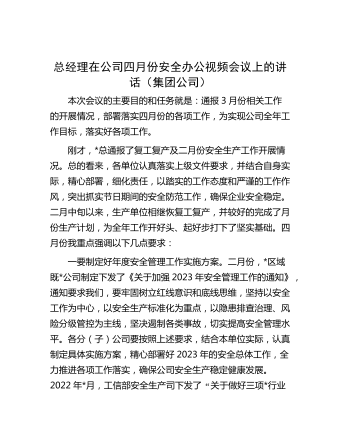
总经理在公司四月份安全办公视频会议上的讲话(集团公司)
本次会议的主要目的和任务就是:通报3月份相关工作的开展情况,部署落实四月份的各项工作,为实现公司全年工作目标,落实好各项工作。刚才,*总通报了复工复产及二月份安全生产工作开展情况。总的看来,各单位认真落实上级文件要求,并结合自身实际,精心部署,细化责任,以踏实的工作态度和严谨的工作作风,突出抓实节日期间的安全防范工作,确保企业安全稳定。二月中旬以来,生产单位相继恢复工复产,并较好的完成了月份生产计划,为全年工作开好头、起好步打下了坚实基础。四月份我重点强调以下几点要求:一要制定好年度安全管理工作实施方案。二月份,*区域既*公司制定下发了《关于加强2023年安全管理工作的通知》,通知要求我们,要牢固树立红线意识和底线思维,坚持以安全工作为中心,以安全生产标准化为重点,以隐患排查治理、风险分级管控为主线,坚决遏制各类事故,切实提高安全管理水平。各分(子)公司要按照上述要求,结合本单位实际,认真制定具体实施方案,精心部署好2023年的安全总体工作,全力推进各项工作落实,确保公司安全生产稳定健康发展。
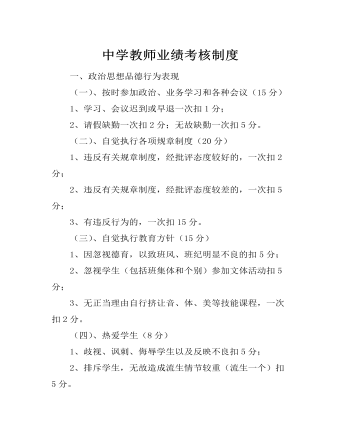
中学教师业绩考核制度
(二)、自觉执行各项规章制度(20分) 1、违反有关规章制度,经批评态度较好的,一次扣2分; 2、违反有关规章制度,经批评态度较差的,一次扣5分; 3、有违反行为的,一次扣15分。 (三)、自觉执行教育方针(15分) 1、因忽视德育,以致班风、班纪明显不良的扣5分; 2、忽视学生(包括班集体和个别)参加文体活动扣5分;
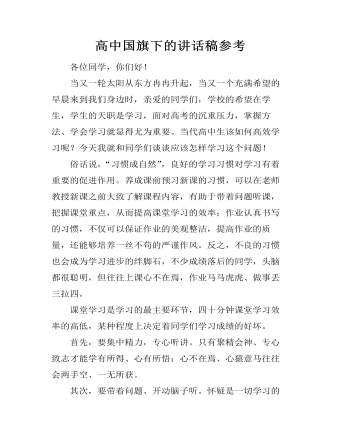
高中国旗下的讲话稿参考
各位同学,你们好!当又一轮太阳从东方冉冉升起,当又一个充满希望的早晨来到我们身边时,亲爱的同学们,学校的希望在学生,学生的天职是学习,面对高考的沉重压力,掌握方法、学会学习就显得尤为重要。当代高中生该如何高效学习呢?今天我就和同学们谈谈应该怎样学习这个问题!俗话说,“习惯成自然”,良好的学习习惯对学习有着重要的促进作用。养成课前预习新课的习惯,可以在老师教授新课之前大致了解课程内容,有助于带着问题听课,把握课堂重点,从而提高课堂学习的效率;作业认真书写的习惯,不仅可以保证作业的美观整洁,提高作业的质量,还能够培养一丝不苟的严谨作风。反之,不良的习惯也会成为学习进步的绊脚石,不少成绩落后的同学,头脑都很聪明,但往往上课心不在焉,作业马马虎虎、做事丢三拉四。课堂学习是学习的最主要环节,四十分钟课堂学习效率的高低,某种程度上决定着同学们学习成绩的好坏。首先,要集中精力,专心听讲。只有聚精会神、专心致志才能学有所得、心有所悟;心不在焉、心猿意马往往会两手空、一无所获。

初中月考国旗下讲话稿
不知不觉中月考又来临了。月考测试是对我们一学期学习成果的检验和展示。下面是小编为您整理的关于初中月考国旗下讲话稿的相关资料,欢迎阅读!初中月考国旗下讲话稿 例1 尊敬的领导、老师、同学们:早上好,今天,我演讲的题目是——做最好的自己。国旗下讲话迎接月考本周将进行月考,这不仅仅是为了检测同学们近阶段的学习成果,更是给同学们搭建一个向学校和家长展现自己的舞台,怎么才能在这个考试中展现自己?答案就是:做最好的自己。怎么才能做到?我觉得应该做到以下几点:国旗下讲话迎接月考第一,要敢于超越自我。在这个世界上最难战胜和超越的不是别人,而是自己。要如何超越自己呢?首先要有充足的信心,坚信自己能够做到;其次明确找出自己的不足,制定合理地计划加以弥补;最后要有强大的意志力,将自己的计划执行下去。第二,充分利用时间。怎样在短短的时间内吸收更多的知识呢?我认为要紧紧抓住课上时间,提高学习效率。充分利用往往被忽视的小块时间,进行复习通过自我控制,养成每天复习的好习惯。第三,要讲究学习方法一个好的学习方法,往往事半功倍。一个好的学习方法的关键是课上学习效率,而课上学习效率提高起来并不难,只需要我们同学每天做好课前预习、课上认真听课、重点内容记录课下多多复习就好了。
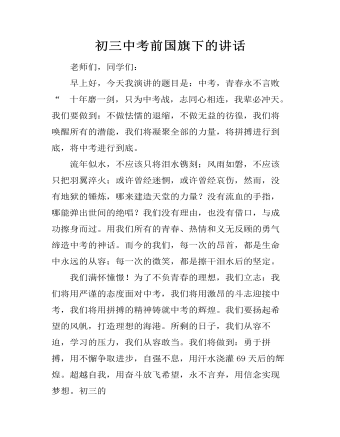
初三中考前国旗下的讲话
老师们,同学们:早上好,今天我演讲的题目是:中考,青春永不言败“ 十年磨一剑,只为中考战,志同心相连,我辈必冲天。我们要做到:不做怯懦的退缩,不做无益的彷徨,我们将唤醒所有的潜能,我们将凝聚全部的力量,将拼搏进行到底,将中考进行到底。流年似水,不应该只将泪水镌刻;风雨如磐,不应该只把羽翼淬火;或许曾经迷惘,或许曾经哀伤,然而,没有地狱的锤炼,哪来建造天堂的力量?没有流血的手指,哪能弹出世间的绝唱?我们没有理由,也没有借口,与成功擦身而过。用我们所有的青春、热情和义无反顾的勇气缔造中考的神话。而今的我们,每一次的昂首,都是生命中永远的从容;每一次的微笑,都是擦干泪水后的坚定。我们满怀憧憬!为了不负青春的理想,我们立志:我们将用严谨的态度面对中考,我们将用激昂的斗志迎接中考,我们将用拼搏的精神铸就中考的辉煌。我们要扬起希望的风帆,打造理想的海港。所剩的日子,我们从容不迫,学习的压力,我们从容敢当。我们将做到:勇于拼搏,用不懈争取进步,自强不息,用汗水浇灌69天后的辉煌。超越自我,用奋斗放飞希望,永不言弃,用信念实现梦想。初三的莘莘学子们行动起来吧,让我们共同拼搏,实现我们的理想,让青春绽放最美丽的光芒。
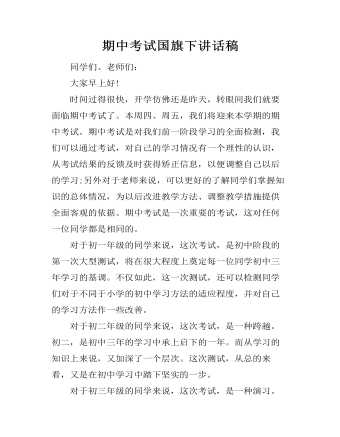
期中考试国旗下讲话稿
同学们、老师们:大家早上好!时间过得很快,开学仿佛还是昨天,转眼间我们就要面临期中考试了。本周四、周五,我们将迎来本学期的期中考试。期中考试是对我们前一阶段学习的全面检测,我们可以通过考试,对自己的学习情况有一个理性的认识,从考试结果的反馈及时获得矫正信息,以便调整自己以后的学习;另外对于老师来说,可以更好的了解同学们掌握知识的总体情况,为以后改进教学方法、调整教学措施提供全面客观的依据。期中考试是一次重要的考试,这对任何一位同学都是相同的。对于初一年级的同学来说,这次考试,是初中阶段的第一次大型测试,将在很大程度上奠定每一位同学初中三年学习的基调。不仅如此,这一次测试,还可以检测同学们对于不同于小学的初中学习方法的适应程度,并对自己的学习方法作一些改善。对于初二年级的同学来说,这次考试,是一种跨越。初二,是初中三年的学习中承上启下的一年。而从学习的知识上来说,又加深了一个层次。这次测试,从总的来看,又是在初中学习中踏下坚实的一步。
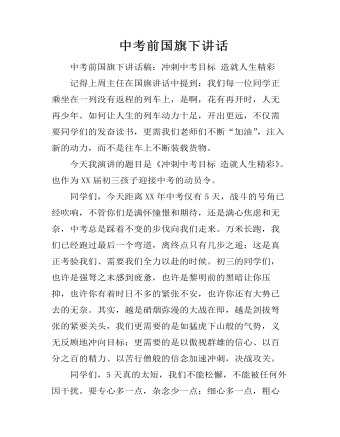
中考前国旗下讲话
中考前国旗下讲话稿:冲刺中考目标 造就人生精彩记得上周主任在国旗讲话中提到:我们每一位同学正乘坐在一列没有返程的列车上,是啊,花有再开时,人无再少年。如何让人生的列车动力十足,开出更远,不仅需要同学们的发奋读书,更需我们老师们不断“加油”,注入新的动力,而不是往车上不断装载货物。今天我演讲的题目是《冲刺中考目标 造就人生精彩》。也作为XX届初三孩子迎接中考的动员令。同学们,今天距离XX年中考仅有5天,战斗的号角已经吹响,不管你们是满怀憧憬和期待,还是满心焦虑和无奈,中考总是踩着不变的步伐向我们走来。万米长跑,我们已经跑过最后一个弯道,离终点只有几步之遥;这是真正考验我们、需要我们全力以赴的时候。初三的同学们,也许是强弩之末感到疲惫,也许是黎明前的黑暗让你压抑,也许你有着时日不多的紧张不安,也许你还有大势已去的无奈。其实,越是硝烟弥漫的大战在即,越是剑拔弩张的紧要关头,我们更需要的是如猛虎下山般的气势,义无反顾地冲向目标;更需要的是以傲视群雄的信心、以百分之百的精力、以苦行僧般的信念加速冲刺,决战攻关。
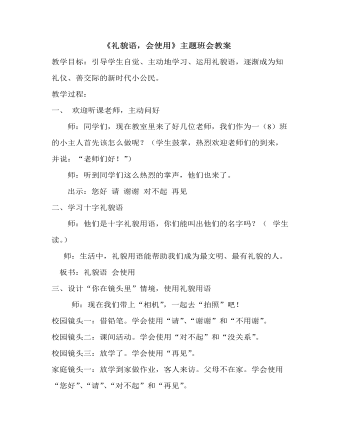
《礼貌语 会使用》主题班会教案
教学目标:引导学生自觉、主动地学习、运用礼貌语,逐渐成为知礼仪、善交际的新时代小公民。教学过程:一、 欢迎听课老师,主动问好 师:同学们,现在教室里来了好几位老师,我们作为一(8)班的小主人首先该怎么做呢?(学生鼓掌,热烈欢迎老师们的到来,并说:“老师们好!”)师:听到同学们这么热烈的掌声,他们也来了。出示:您好 请 谢谢 对不起 再见二、学习十字礼貌语师:他们是十字礼貌用语,你们能叫出他们的名字吗?( 学生读。)师:生活中,礼貌用语能帮助我们成为最文明、最有礼貌的人。板书:礼貌语 会使用
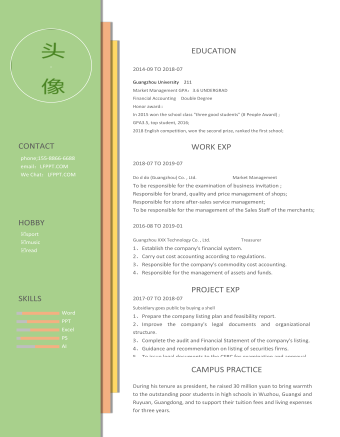
英文简历+中文简历
GuangzhouUniversity 211Market Management GPA:3.6 UNDERGRADFinancial Accounting Double DegreeHonor award::In 2015 won the school class"three good students" (# People Award) ;GPA3.5, top student, 2016;2018 English competition, won thesecond prize, ranked the first school;

2024年XX市上半年信访工作总结
三、下步工作(一)守牢基层化解“主阵地”,竭力遏上行。深入开展矛盾纠纷排查化解,有效减少矛盾积累、问题上行、风险外溢。发挥常态化安保指挥部作用,对风险隐患进行预警和化解处置。(二)打好规范办理“主动仗”,全面提质效。对事项按照“十步法”,落实“三到位”,切实形成闭环,防止初转重。建立国家局登记求决类初件包保机制,确保程序性办结和实质性化解。对重复事项要溯源复盘,摸清缘由经过、主要诉求、政策依据、症结难点等,力争化解,防止重转积。对不满意件、未参评件高度关注,要求责任单位继续做好教育疏导工作,加强督查督办,既督问题解决、也查首办责任,属于失职失责的,提出追责问责建议。(三)啃下积案化解“硬骨头”,确保真解决。从讲政治的高度扛起重点事项化解责任,严格落实专班责任制,实行“一案一策、一人一专班”,找准事项突破口、压缩化解时限,办一件、结一件、了一件,确保事项真化解。
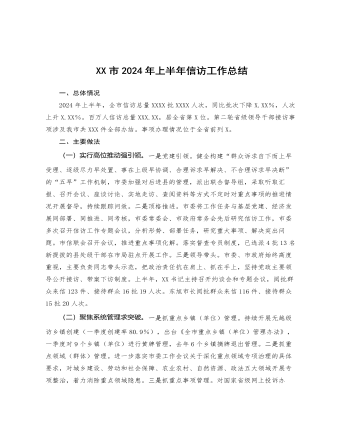
XX市2024年上半年信访工作总结
(一)守牢基层化解“主阵地”,竭力遏上行。深入开展矛盾纠纷排查化解,有效减少矛盾积累、问题上行、风险外溢。发挥常态化安保指挥部作用,对风险隐患进行预警和化解处置。(二)打好规范办理“主动仗”,全面提质效。对事项按照“十步法”,落实“三到位”,切实形成闭环,防止初转重。建立国家局登记求决类初件包保机制,确保程序性办结和实质性化解。对重复事项要溯源复盘,摸清缘由经过、主要诉求、政策依据、症结难点等,力争化解,防止重转积。对不满意件、未参评件高度关注,要求责任单位继续做好教育疏导工作,加强督查督办,既督问题解决、也查首办责任,属于失职失责的,提出追责问责建议。(三)啃下积案化解“硬骨头”,确保真解决。从讲政治的高度扛起重点事项化解责任,严格落实专班责任制,实行“一案一策、一人一专班”,找准事项突破口、压缩化解时限,办一件、结一件、了一件,确保事项真化解。
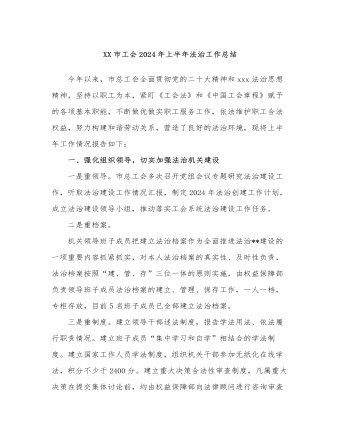
XX市工会2024年上半年法治工作总结
二是依法做好劳动争议调解工作。组建职工法律服务团,吸纳13名专业突出、热心公益的律师参与,明确法律援助工作流程及补贴标准,及时为职工提供专业、全面的法律咨询服务,引导职工依法理性表达诉求,今年接待职工来访100人次。联合市中级人民法院开展“法院+工会”劳动争议诉调对接工作,并在*市建立示范点,办理案件3件。三是全面提升工会法治建设水平。职工服务中心是各级工会组织开展法治宣传、服务职工的主要阵地。大力推动一站式职工服务中心建设,在全市范围内打造以市职工服务中心为龙头、乡镇(科局)职工服务中心为骨干,社区(村)职工服务中心为基础、企业职工服务中心为支撑的四级服务职工网络。服务中心设置了“政策咨询”、“法律援助”、“劳动争议调处”、“信访接待”、“心灵聊吧”和“权益维护”等服务窗口,促进工会法治建设进入了规范化、制度化和机制化轨道。
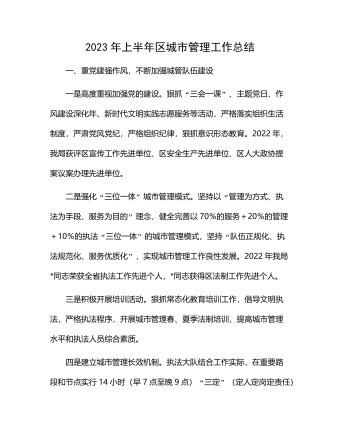
2024年上半年区城市管理工作总结
三是补齐市政设施建设短板。按照“花小钱、办实事”的原则,开展“城市体检”,排查城市污水、排水井116个,更换污水井盖27个、排水井12个;排查城市路灯1470个,更换维修310个;对城区21座桥梁进行安全排查,整改安全隐患4处;维护主次干道46处计5.11公里,维修人行道青石板453平方,更换城区损坏破损的座椅55把,疏通雨水管道216米,整治“空中管线”55处。五、重长效强监管,城市安全管理实现新突破一是大力开展油烟污染治理。对城区79家机关企事业单位,127家餐饮企业及城区工地食堂开展油烟污染全面排查检测1次,下发整改通知25份。实施规范管理,定期开展执法检查,要求“三个灶台”及以上必须安装油烟净化器,并聘请专业清洗公司对油烟净化器定期进行清洗,建立清洗台账,做好台账式管理,目前城区油烟净化装置安装使用率95%以上,达标排放率90%以上。
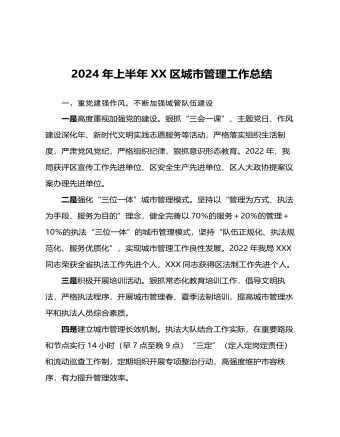
2024年上半年XX区城市管理工作总结
三是补齐市政设施建设短板。按照“花小钱、办实事”的原则,开展“城市体检”,排查城市污水、排水井116个,更换污水井盖27个、排水井12个;排查城市路灯1470个,更换维修310个;对城区21座桥梁进行安全排查,整改安全隐患4处;维护主次干道46处计5.11公里,维修人行道青石板453平方,更换城区损坏破损的座椅55把,疏通雨水管道216米,整治“空中管线”55处。五、重长效强监管,城市安全管理实现新突破一是大力开展油烟污染治理。对城区79家机关企事业单位,127家餐饮企业及城区工地食堂开展油烟污染全面排查检测1次,下发整改通知25份。实施规范管理,定期开展执法检查,要求“三个灶台”及以上必须安装油烟净化器,并聘请专业清洗公司对油烟净化器定期进行清洗,建立清洗台账,做好台账式管理,目前城区油烟净化装置安装使用率95%以上,达标排放率90%以上。
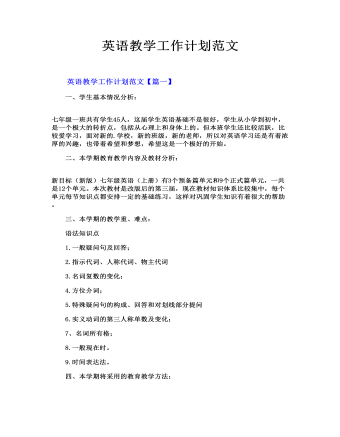
英语教学工作计划范文
1.用英语教英语(Teach English inEnglish); 英语毕竟是一门语言,训练的是学生的听、说、读、写、译的综合能力,在教学的过程中需要对学生的听、说、读、写、译的能力进行很多的训练,这就要求我们用英语来教英语,在课堂上对学生进行各种能力的训练。




